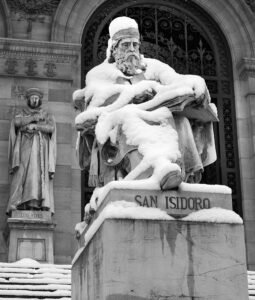14 Miraculous Influences of St. Isidore of Seville: How His Devotion Can Change Your Life
St. Isidore of Seville, known for his scholarship, piety, and unwavering faith, is an inspiration to millions of people around the world. St. Isidore of Seville gave us teachings and writings that continue to guide us, even centuries after his death.
In this blog post, we will explore the fascinating life of St. Isidore, his contributions to the Church and society, and his enduring impact on the world.
So let us begin our journey into the world of St. Isidore of Seville!

What does the name Isidore mean?
Isidore was a common name in ancient Greece and Rome, and it was often given to children born under auspicious circumstances, as a sign of good luck and prosperity.
St. Isidore of Seville was born in the year 560 AD in Cartagena, Spain. He was raised in a noble family and shown a strong knack for learning even as a young child. He studied under some of the most renowned scholars of his time, and he quickly gained a reputation for his erudition and intellect.
What is St. Isidore of Seville known for?
St. Isidore of Seville is known for his many contributions to the field of theology, philosophy, and education. He wrote over 30 books on subjects like history, science, and theology.
One of his most significant contributions was his encyclopedic work, the Etymologies, which is a comprehensive dictionary of the knowledge of his time. The book contains over 20,000 entries on topics ranging from grammar and language to geography and theology. The Etymologies was a groundbreaking work that helped to shape the course of medieval scholarship, and it remained a popular reference work for centuries.
St. Isidore of Seville was also a champion of education, and he believed that knowledge was essential for the spiritual and intellectual growth of individuals and societies. He played a key role in establishing schools and libraries throughout Spain, and he encouraged the study of classical literature and philosophy.
In addition to his intellectual contributions, St. Isidore of Seville was known for his compassion and generosity. He was deeply committed to helping the poor and marginalized, and he established many charitable organizations to support them.
St. Isidore of Seville died in the year 636 AD, and he was canonized by the Catholic Church in 1598.
Where is St. Isidore of Seville buried?
St. Isidore of Seville was laid to rest in the city of Seville, Spain, where he spent the majority of his life. According to tradition, St. Isidore of Seville was buried in the Basilica of San Isidoro de Sevilla, a grand and impressive church that was built in his honor in the 13th century.
The Basilica of San Isidoro de Sevilla is a magnificent example of medieval architecture, featuring a stunning mix of Gothic, Renaissance, and Baroque styles. The church has long been a pilgrimage site for those seeking to pay their respects to St. Isidore of Seville and to seek his intercession.
Inside the Basilica, visitors can find St. Isidore’s tomb, which is located in the chapel that bears his name. The tomb is an ornate and elaborate structure, adorned with intricate carvings and decorative elements that serve as a testament to the great esteem in which St. Isidore of Seville is held.
St. Isidore’s tomb is a place of great reverence and inspiration for many, and countless pilgrims have come to pray and seek his intercession over the centuries. It is said that those who pray at St. Isidore’s tomb are granted special blessings and graces, and that his intercession has brought about countless miracles and healings.
The final resting place of St. Isidore of Seville is a testament to his enduring legacy and the profound impact he has had on the Church and Western culture. The Basilica of San Isidoro de Sevilla serves as a lasting tribute to this great saint, and his tomb is a place of pilgrimage and inspiration for many. May we continue to honor and seek the intercession of St. Isidore of Seville, as we strive to live a life of faith, humility, and service to others.
Is the body of Saint Isidore incorruptible?
St. Isidore is incorruptible. This refers to the phenomenon where the bodies of some saints do not decay after death, but instead remain intact and preserved.
There are conflicting reports about whether St. Isidore’s body is incorruptible. Some sources claim that his body was found to be intact when it was exhumed many years after his death, while others claim that it had decayed.
However, regardless of whether his body is incorruptible or not, St. Isidore’s legacy lives on through the many people whose lives he touched and the teachings he left behind.
How can I make a pilgrimage to visit St. Isidore of Seville at The Basilica of San Isidoro de Sevilla?
If you are a devoted follower of St. Isidore of Seville or simply interested in learning more about this great saint, you may wish to make a pilgrimage to his final resting place at the Basilica of San Isidoro de Sevilla. Here are some things you can do to help you prepare for your visit…
- Research the Basilica: Before embarking on your pilgrimage, it is essential to do some research on the Basilica of San Isidoro de Sevilla. This will help you understand the significance of the site and what to expect during your visit. You can also find information about opening hours, admission fees, and other practical details.
- Plan your itinerary: Depending on where you are coming from, you may need to plan your itinerary carefully to ensure that you can visit the Basilica during its opening hours. You may also wish to explore other sites of religious significance in Seville, such as the Cathedral of Seville or the Alcázar of Seville.
- Consider guided tours: The Basilica of San Isidoro de Sevilla offers guided tours that can help you fully appreciate the history and significance of the site. You can also consider hiring a private tour guide who can provide additional insight and context.
- Prepare spiritually: A pilgrimage is not just a physical journey, but also a spiritual one. Take time to prepare spiritually before your visit, by reading about St. Isidore’s life and teachings, and by dedicating time for prayer and reflection.
- Respect the sacred space: When visiting the Basilica of San Isidoro de Sevilla, it is essential to be respectful of the sacred space and the other visitors. This means dressing appropriately, observing silence and reverence, and refraining from taking photos or videos inside the church.
- Seek St. Isidore’s intercession: Finally, remember that the ultimate goal of a pilgrimage is to seek spiritual renewal and to deepen your relationship with God. Take time to pray and seek the intercession of St. Isidore of Seville, asking for his guidance and protection on your journey.

A pilgrimage to the Basilica of San Isidoro de Sevilla can be a profound and enriching experience for anyone seeking to deepen their faith and understanding of St. Isidore of Seville. By planning your visit carefully, preparing spiritually, and approaching the pilgrimage with reverence and humility, you can connect with the rich spiritual legacy of this great saint and draw closer to God.
I love traveling and traveling to see the saints will change your life forever. I know you’re thinking of going to Seville and seeing St. Isidore and I want you to be able to make the most out of your trip.
So, I put together a fun day trip for you HERE. Click on the picture of Seville below and get more of details.

What are 3 facts about Saint Isidore?
Let us explore three interesting facts about this remarkable saint.
- St. Isidore of Seville was born into a noble family in Spain, and he grew up in a highly-educated environment. His siblings, Leander, Fulgentius, and Florentina, were all canonized as saints, and his brother Leander played a key role in converting the Visigoths to Christianity.
- St. Isidore of Seville was a prolific writer, and he is known for his many contributions to the field of theology, philosophy, and education. His most famous work, the Etymologies, was a comprehensive encyclopedia of knowledge in his time and became a standard reference work throughout the Middle Ages.
- St. Isidore of Seville was known for his compassion and generosity towards the poor and marginalized. He established many charitable organizations to help those in need, and he used his influence to speak out against the injustices of the powerful.

How did the angel help St. Isidore?
According to legend, St. Isidore of Seville was once plowing a field when he saw a group of angels coming towards him. One of the angels asked him to stop working and pray with them. St. Isidore of Seville complied, and he prayed fervently with the angels.
After they finished praying, the angel touched the ground with his staff, and a fountain of water sprang forth. The angel told St. Isidore of Seville that the water would be a source of healing for many people, and he instructed him to share it with others.
St. Isidore followed the angel’s instructions and shared the water with those in need. The water was said to have miraculous healing properties, and many people were cured of their ailments.
This story illustrates the deep faith and devotion of St. Isidore, as well as his willingness to follow the guidance of the angels. It also shows his dedication to helping others and his belief in the power of prayer and miracles.
In conclusion, St. Isidore of Seville was a remarkable figure in the history of the Catholic Church, whose wisdom, compassion, and faith continue to inspire people around the world. Let us honor his memory by continuing to follow in his footsteps and strive for a more just and compassionate world.
Best Saint Isidore of Seville Quotes
Now, let us turn our attention to some of the best quotes by St. Isidore of Seville. His words continue to inspire and guide us even today, centuries after his death.
- “Knowledge without wisdom is double folly.”
This quote reminds us that knowledge alone is not enough. We must also possess wisdom, which is the ability to use knowledge in a wise and effective manner.
- “Faith is to believe what you do not see; the reward of this faith is to see what you believe.”
This quote speaks to the power of faith, which allows us to see beyond what is immediately visible and to believe in things that cannot be proven by reason alone.
- “Learn as if you were to live forever; live as if you were to die tomorrow.”
This quote reminds us of the importance of living each day to the fullest and making the most of our time on earth. It also highlights the value of lifelong learning and personal growth.
- “The heart of the wise man lies quiet like limpid water.”
This quote speaks to the importance of inner peace and tranquility, which can be achieved through wisdom and a calm spirit.
- “He who is humble is confident and wise. He who brags is insecure and lacking.”
This quote reminds us of the importance of humility, which is a virtue that allows us to recognize our own limitations and to value the contributions of others.
St. Isidore of Seville was a wise and compassionate saint whose teachings continue to inspire us today. Whether his body is incorruptible or not is a matter of debate, but his legacy of wisdom, piety, and generosity lives on through his words and deeds.
What is Saint Isidore of Seville feast day?

Saint Isidore’s feast day is celebrated on April 4th.
On this day, many people throughout the world commemorate his life and accomplishments, and offer prayers to ask for his intercession and guidance in their own lives. Saint Isidore is remembered as a powerful intercessor and patron saint of farmers, peasants, and rural communities.
What miracles are associated with St. Isidore?
Now, let us turn our attention to the miracles associated with Saint Isidore. Throughout his life, Saint Isidore was known for his great faith and devotion to God. He was said to have performed many miracles, which helped to spread the Christian faith and bring comfort to those who were suffering.
One of the most famous miracles associated with Saint Isidore is the story of how an angel helped him to plow his fields. According to the legend, Saint Isidore was a farmer who was known for his piety and hard work. One day, while he was plowing his fields, he became so lost in prayer that he did not notice the time passing.
As a result, he fell behind in his work, and his fellow farmers laughed at him and called him lazy. But then, an angel appeared to Saint Isidore and helped him to plow his fields at an incredible speed. With the angel’s help, Saint Isidore was able to catch up with his work and finish it all in one day. The other farmers were amazed by this miracle and came to respect and admire Saint Isidore.
Another famous miracle attributed to Saint Isidore is the story of how he saved a child from drowning. The story claims that Saint Isidore was passing by a river when he heard a child’s cries after they had fallen into the water. Without hesitation, Saint Isidore plunged into the river and pulled the child to safety. The child’s parents were overjoyed and attributed the miracle to Saint Isidore’s intercession.
St. Isidore of Seville was a man of great faith and holiness, whose life was filled with many miraculous events. His feast day is celebrated on April 4th, and he is remembered as a powerful intercessor and patron saint of farmers, peasants, and rural communities. The miracles associated with him serve as a testament to his great faith and devotion to God, and continue to inspire and uplift us today. Thank you for reading, and may the life and legacy of Saint Isidore of Seville continue to shine brightly for generations to come.
What are some Isidore of Seville books?
St. Isidore of Seville is known for his significant contributions to the literary world during the 6th and 7th centuries. Some of his most well-known works include “Etymologiae,” “Historia de regibus Gothorum, Vandalorum et Suevorum,” and “De Natura Rerum.”
“Etymologiae,” also known as the “Origins,” is perhaps his most famous work. It is an encyclopedia that covers a wide range of subjects, including grammar, rhetoric, music, medicine, law, and theology. It was widely used as a textbook throughout the Middle Ages and was highly regarded for its comprehensive and well-organized content.
“De Natura Rerum,” also known as “On the Nature of Things,” is another significant work by Saint Isidore. It is a compilation of texts on various natural sciences, including physics, astronomy, meteorology, and geography. It was widely read and studied during the Middle Ages and was influential in shaping the scientific worldview of the time.

What is Isidore of Seville patron saint of?
In addition to his literary contributions, Saint Isidore is also known as the patron saint of many things. He is the patron saint of farmers, rural communities, and the internet. This may seem like an unusual combination, but it is believed that Saint Isidore’s association with the internet is due to his reputation as a scholar and his contributions to the dissemination of knowledge.
As the patron saint of farmers and rural communities, Saint Isidore is often invoked for protection and guidance in matters related to agriculture and rural life. His intercession is sought for bountiful harvests, protection against natural disasters, and general well-being.
St. Isidore of Seville was a man of many talents and accomplishments. His literary contributions have stood the test of time and continue to be studied and appreciated to this day. His patronage of farmers, rural communities, and the internet speaks to his broad appeal and enduring legacy. Thank you for reading, and may the life and teachings of St. Isidore of Seville continue to inspire and uplift us for generations to come.
What is St Isidore of Seville prayer?
The Prayer of St. Isidore of Seville is a beautiful and inspiring prayer that can help us to deepen our relationship with God and seek his guidance and blessings in our lives. It goes like this:
“Almighty and eternal God, who made us in His image and commanded us to pursue all that is true, good, and beautiful—especially in the divine person of Thy only-begotten Son, our Lord Jesus Christ—grant we beseech Thee that, through the intercession of St. Isidore of Seville, bishop and physician, we will direct our hands and eyes only to that which is pleasing to Thee and treat with kindness and patience all those souls whom we entrust to Thee while via Christ, our Lord. Amen.”
This prayer is particularly relevant in today’s world, where we are constantly bombarded with distractions and temptations that can lead us away from God. Saint Isidore’s prayer reminds us to seek after all that is good, true, and beautiful, and to treat others with charity and patience, as we journey through life.
How can St. Isidore of Seville help me to become a saint?
But Saint Isidore’s example and intercession can help us to do more than just pray. He can also inspire us to become saints ourselves. Isidore the Great was renowned for his humility, enthusiasm for learning, and commitment to helping others. These are all qualities that we can emulate in our own lives as we strive to become closer to God and live a life of holiness.
Saint Isidore’s commitment to education and the pursuit of knowledge is also a valuable lesson for us today. As we seek to deepen our understanding of God and his teachings, we can follow in Saint Isidore’s footsteps and engage in lifelong learning and intellectual curiosity.
In conclusion, the Prayer of Saint Isidore is a beautiful and inspiring prayer that can help us to seek God’s guidance and blessings in our lives. But Saint Isidore’s example and intercession can also inspire us to become saints ourselves, by living a life of humility, love, and dedication to serving others. May the life and teachings of Saint Isidore continue to guide and inspire us on our journey of faith.
Are You Inspired?
Did today’s lessons provide you with any inspiration? I genuinely love studying and discussing the lives of the saints.
Now, you can convey the life story of St.Isidore of Seville by wearing the amazing blouse I fashioned particularly for you.
Wearing these t-shirts makes it simpler to discuss saints with close friends, family, and random strangers. You may now tell everyone who appreciates your shirt or inquires about it, you can tell them the life story of St. Isidore of Seville and help them to become a saint too.
They could go to church with you so you can tell them the good news there. You might talk about how everybody needs a savior, how Jesus is the ideal sacrifice given to atone for our sins, and how everyone is reliant upon him.
Enrolling them in your parish’s RCIA programs would be far more beneficial.
You can rely on me to keep you in mind when I take action.
To view the shirt design, simply click the image or go HERE. To proceed to the payment page after choosing your preferred size and color, click the BUY NOW button.
Did today’s lessons provide you with any inspiration? I genuinely appreciate studying and discussing the lives of the saints.
For more great saints, visit our blog HERE.
Have a few more minutes to dive into another saint?
Why not learn about:
- The Annunciation to Mary: 9 Cataclysmic Facts how Faith and Surrender Changed the World
- 10 Facts Unveiling the Beauty of “The Annunciation Triptych”: A Masterpiece of Renaissance Art
- St. Patrick: 14 Awe-inspiring Aspects about his Life and Legacy
- St. Louise de Marillac: 15 Inspiring & Unknown Facts on her Life
Have you considered joining us daily to discover more about the Saint of the Day? Please take a moment to sign up if you would want to receive my daily saint emails in your inbox. As I know you have a lot on your plate, I’ll keep it brief, but I genuinely want to tell you more so you can benefit from my experience and grow into a fighter like me.
I’ll also give you a free screensaver for your phone as a special treat. I’ll send you the link to download the upgraded screensaver as soon as you submit the form. Enjoy!
Well, that’s all for today.
I’ll see you back tomorrow with another Saint of the Day to inspire you!
God bless you,
-Priscilla




